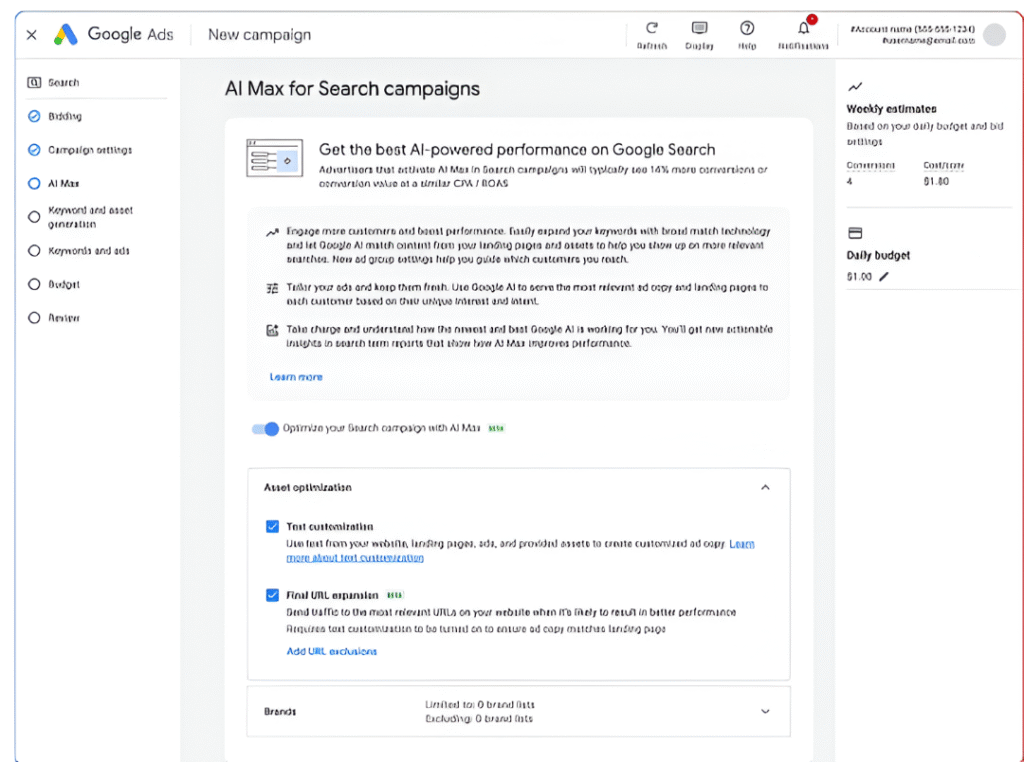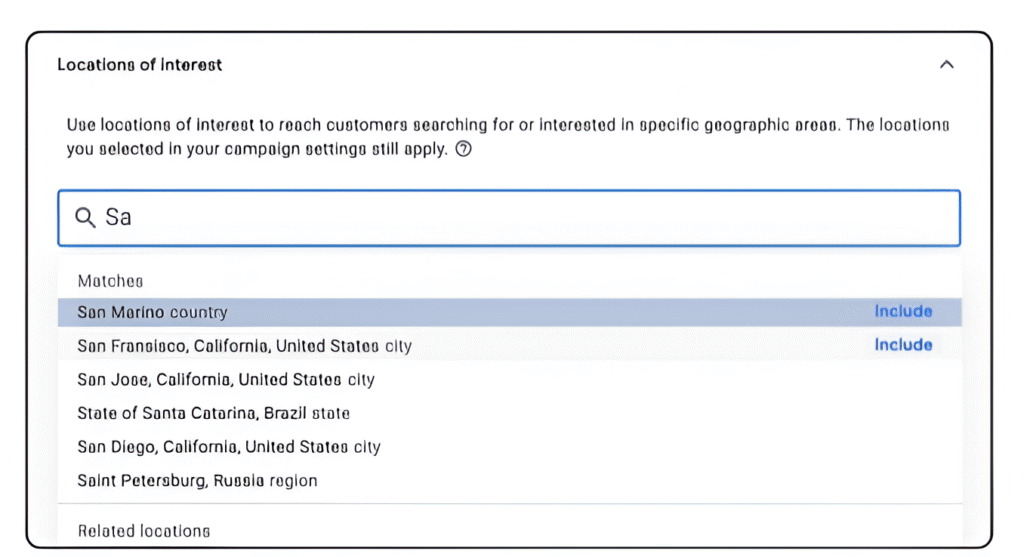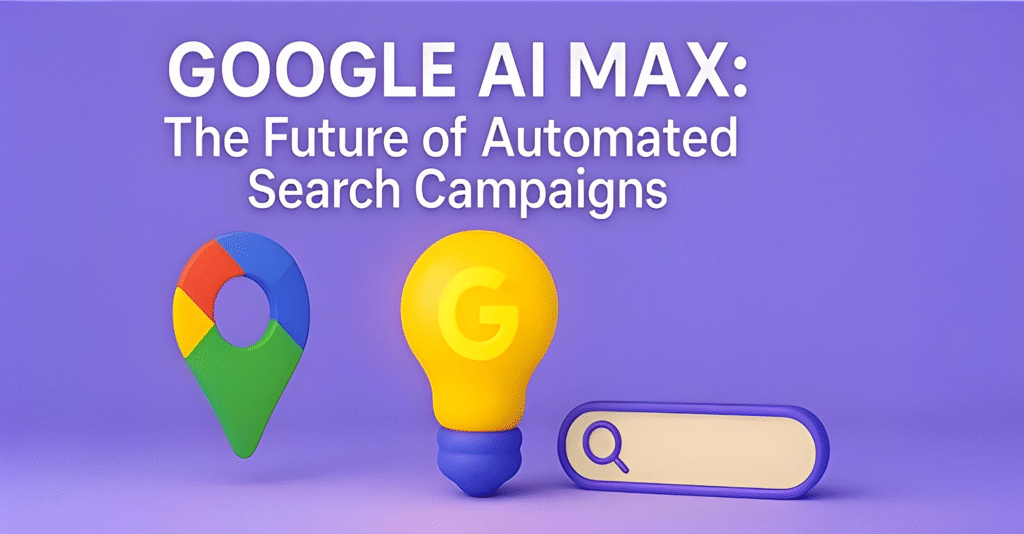Key Points
●Google launched AI Max for Search campaigns in beta, starting globally in May 2025, to enhance ad performance with AI tools.●AI Max is likely to increase conversions by 14% on average, with up to 27% for exact/phrase match campaigns, based on early testing.●It offers expanded reach, relevant ads, and better controls but may not suit all advertisers, especially those with strict guidelines or limited capacity to handle increased volume.
Introduction to AI Max
Google’s AI Max for Search campaigns, launched in beta globally in May 2025, boosts ad performance with AI-driven targeting and creative tools. Despite the playful naming (RIP Search Max), it simplifies optimization while retaining Search campaign control, making it a game-changer for digital marketers. Compare it to other solutions in our Performance Max: Opening the Black Box insights.
Key Features and Benefits
AI Max introduces a robust set of tools to streamline and enhance Search campaigns, focusing on improved reach and creative optimization. It seems likely to expand ad reach to new, high-intent queries, deliver more relevant ads, and provide advanced controls. Key features include:
●One-Click AI Max Toggle: Activates AI-powered targeting and creative tools with a single click, simplifying adoption.●Search Term Matching: Combines broad match and keywordless technology to identify high-performing queries beyond existing keywords, using signals from keywords, assets, and landing pages. Unlike traditional broad match, it doesn’t convert all keywords to broad, preserving existing structures.●Text Customization: Dynamically generates headlines and descriptions based on landing pages, ads, and keywords to align with real-time search intent, using only your existing creative to avoid brand guideline violations.●Final URL Expansion: Directs users to the most relevant landing page, with options to exclude specific URLs, similar to Performance Max.●Locations of Interest: Targets users based on geographic intent (e.g., search queries expressing location) at the ad group level, complementing campaign-level physical location targeting.- Brand Inclusions/Exclusions: Controls which brands ads appear alongside or avoid, at campaign and ad group levels.
●Enhanced Reporting: Offers asset and query-level reporting, including search terms reports with dynamic headlines and URLs, and asset performance metrics (e.g., spend, conversions). A new Value Track URL parameter provides privacy-safe tracking.

Benefits for Advertisers
●Expanded Reach: Captures untapped, high-intent queries, increasing visibility and conversions, ideal for businesses ready to scale.●More Relevant Ads: Real-time customization improves click-through rates and engagement, with safeguards to align with brand standards.●Enhanced Control and Transparency: Granular targeting (e.g., geographic intent, brand exclusions) and detailed reporting ensure advertisers stay in control.●Time Efficiency: Automation reduces manual effort, perfect for large-scale campaigns.
These benefits make AI Max a powerful tool for advertisers aiming to optimize campaigns efficiently, particularly those with the infrastructure to handle increased conversions at similar CPA. For expert management of such advanced tools, explore our PPC Management services.
Performance and Availability
Early testing suggests AI Max delivers impressive results:
●14% average increase in conversions or conversion value at similar cost-per-acquisition (CPA) or return on ad spend (ROAS).●Up to 27% uplift for campaigns using exact or phrase match keywords.
Real-world examples include:
●L’Oréal: Achieved a 2x higher conversion rate and 31% lower cost-per-conversion by targeting niche queries like “best cream for facial dark spots.”●MyConnect: Saw 16% more leads at a 13% lower cost-per-action, with 30% more conversions from new queries.
AI Max is currently in beta, with a global rollout starting later this month (May 2025). Full availability is expected by early Q3 2025, likely July 2025. Advertisers can contact their Google Ads representative for beta access (Google Ads Help). Note that API and Editor support is planned for H2 2025, so manual activation is recommended to avoid workflow disruptions.
Exploring Google’s AI Max for Search Campaigns

Background and Purpose
Announced May 6, 2025, AI Max is an opt-in feature suite for Search campaigns, integrating AI-powered targeting and creative tools. It enhances query matching and creative generation without altering keywords, improving on broad match campaigns while retaining Search control. Ideal for capturing demand and boosting conversions, it aligns with Google’s AI initiatives like AI Overviews. Explore automation in our Performance Max: Opening the Black Box analysis.
What is AI Max?
AI Max is an opt-in Google Search campaign setting enhancing keyword targeting, location/brand intent, and URL expansion with AI. It improves broad match and Dynamic Search Ads (DSA) by adding query matching and creative enhancements, allowing removal of non-compliant AI-generated headlines. Focused on increasing reach, it’s ideal for businesses ready to handle more conversions at similar CPA. DSA campaigns remain available.
Who is AI Max For?
AI Max suits advertisers using Search and Performance Max, especially with exact/phrase match keywords or partial Performance Max adoption. It’s critical for ecommerce but needs cautious testing for lead gen, where volume may strain operations. Strict industries (e.g., law, finance, health) or dynamic websites may face challenges with text customization and URL expansion, similar to DSA limitations.
Key Features in Detail
AI Max’s tools are designed to simplify campaign management while boosting results. Here’s a closer look:
| Feature | Description |
| One-Click AI Max Toggle | Activates AI tools within existing Search campaigns, reducing setup time. |
| Search Term Matching | Uses broad match and keywordless tech to find high-performing queries, following keyword prioritization logic, without converting all keywords to broad. |
| Text Customization | Generates dynamic headlines and descriptions based on your landing pages, ads, and keywords, using only existing creative to ensure brand compliance. |
| Final URL Expansion | Sends users to the most relevant landing page, with URL exclusion options, similar to Performance Max. Not recommended if pinning is required. |
| Locations of Interest | Targets geographic intent at the ad group level, prioritizing expressed search intent (e.g., “hotels in Paris”) over physical location, complementing campaign-level settings. |
| Brand Inclusions/Exclusions | Controls brand associations at campaign and ad group levels, with additional exclusions exclusive to AI Max. |
| Enhanced Reporting | Provides asset and query-level reporting, including search terms reports with dynamic headlines and URLs, asset performance metrics, and a Value Track URL parameter for tracking. |
These features leverage Google’s AI to predict and adapt to search behaviors, reducing manual effort while ensuring ads remain relevant and effective. The ability to remove non-compliant AI-generated assets is a significant improvement over traditional DSA functionality.
Benefits for Advertisers
AI Max addresses key challenges in Search advertising:
●Expanded Reach: Identifies new, high-performing queries, helping ads appear in untapped search moments, perfect for growth-focused campaigns.●More Relevant Ads: Dynamic customization aligns ads with user intent, boosting engagement, with safeguards to prevent brand violations.●Enhanced Control: Options like geographic intent targeting, brand exclusions, and negative keywords (functioning as in traditional Search) offer precision.●Time Efficiency: Automation frees up time for strategic planning, ideal for scaling campaigns.
These advantages are particularly appealing for advertisers scaling campaigns or seeking better ROI. To leverage such tools effectively, consider hiring a Digital Marketer with expertise in AI-driven advertising.
Performance Results and Case Studies
Google’s internal data highlights AI Max’s potential:
●14% more conversions at similar CPA/ROAS for campaigns with over 70% conversions from exact or phrase match keywords (non-Retail).●27% uplift for exact/phrase match-focused campaigns.
Case studies include:
●L’Oréal: Doubled conversion rates and cut costs by 31% by targeting niche queries like “best cream for facial dark spots.”●MyConnect: Gained 16% more leads at 13% lower CPA, with 30% more conversions from new queries.
These results, based on Google’s 2025 internal data, suggest AI Max can drive substantial growth, though outcomes depend on industry and campaign setup. The focus on volume makes it particularly effective for large ecommerce brands.
Availability and Access
AI Max is in beta, rolling out globally from May 2025, with full availability expected by early Q3 2025, likely July 2025. Advertisers can contact their Google Ads representative for access (Google Ads Help). API and Editor integration is planned for H2 2025, so advertisers should plan for manual activation to avoid workflow disruptions. Reporting will be supported in API, Report Editor, and Desktop Editor in H2 2025.
Key Questions and Answers
Insights from a Google roundtable with Ginny Marvin provide clarity on AI Max’s applications:
●Who is the ideal customer?
Advertisers using Search and Performance Max should test AI Max, especially those relying on exact/phrase match keywords. It boosts results for Search-only spend with additional controls and reporting.●What signals indicate it’s worth testing?
If you have Search-only campaigns, AI Max can enhance ROAS/conversions by leveraging advanced AI tech.●Do exclusions work the same as traditional Search?
Negative keywords function as usual, with added brand exclusions and ad group-level controls exclusive to AI Max.●Are locations interest-based or physical?
Locations of interest prioritize expressed search intent over physical location. Both campaign-level physical location and ad group-level intent must be met, enabling new use cases (e.g., targeting users in one location searching for another).●Does AI Max get preferential SERP placement?
AI Max doesn’t alter auction dynamics. Search, Performance Max, and Shopping campaigns (with or without AI Max) are eligible for new experiences like AI Overviews.●How does AI Max protect creative from competitors?
Text customization uses only your landing pages, ads, and keywords, ensuring no external use.●Does AI Max take precedence in auctions?
Search campaigns with identical keyword matches (any match type) are prioritized over Performance Max or AI Max expansions. Otherwise, the highest Ad Rank wins. Trumping rules remain unchanged.●Can you A/B test AI Max?
Drafts & experiments are available, with more customized A/B testing planned.●Can you opt out of specific features?
All three features (search term matching, text customization, final URL expansion) activate together, but you can opt out of text customization and final URL expansion at the campaign level, or search term matching at the ad group level. Using all three is recommended.●What informs generated assets?
Assets are based on your landing pages, ads, and keywords. You can remove unwanted assets.●How does AI Max prevent irrelevant searches?
Search term matching targets high-performing traffic, with safeguards to lower bids if ROI falls short.●Will language settings be ad group-level?
Not planned; matching uses campaign language settings and creative/landing page language.●What does the Value Track URL parameter track?
Details are forthcoming on the Google Ads Help Center.●Is reporting supported in API/Editors?
Support is planned for H2 2025.
Considerations for Advertisers
AI Max offers exciting opportunities but isn’t universal. Key considerations include:
●Industry Suitability: Sensitive verticals (e.g., law, finance, health) or brands with strict guidelines may struggle with automated creatives or URL expansion, similar to DSA challenges. Text customization is not recommended for these advertisers.●Website Dynamics: Rapidly changing sites require monitoring to ensure URL accuracy. Avoid final URL expansion if pinning is needed.●Testing and Optimization: Use drafts & experiments for A/B testing, optimize landing pages, and maintain negative keywords to avoid irrelevant traffic. AI Max includes safeguards to lower bids for underperforming traffic.●Volume Capacity: AI Max prioritizes growth over efficiency, so businesses must handle increased conversions without operational strain. Ecommerce brands are ideal, while lead gen businesses need to assess capacity.●Brand Control: You can remove non-compliant AI-generated assets, but reactive monitoring is needed.●Structural Shifts: AI Max favors smaller account structures, requiring testing alignment. Ad group-level brand controls simplify structuring.
For lead generation, ask these questions before opting in:
●How many leads can you handle without operational changes?●Are brand violations a concern, requiring proactive creative removal?●Are you ready for smaller account structures to test AI Max effectively?●Can you collaborate with SEO teams to action insights from queries and website content?
Ecommerce brands, especially large ones, are prime candidates due to their ability to scale, while lead gen businesses should test cautiously, as increased volume may not align with goals if conversion rates are the priority. For tailored strategies, explore our PPC Management services.
Conclusion and Future Implications
Google’s AI Max for Search campaigns brings Performance Max’s AI power to Search, promising up to 14% more conversions (27% for exact/phrase match). Ideal for ecommerce, it requires cautious testing for lead gen. As advertising evolves, AI Max is key for growth. Partner with experts via our Hire a Digital Marketer service to maximize its potential. Share your thoughts on AI Max!
That’s it! If you run into trouble, send me an email at [email protected]

